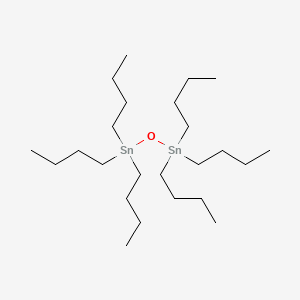D0804 | bis(tributyltin)oxide
| Toxicity | Dose | Time | Species | Model | Method | Action | Positive criterion | Reference |
|---|---|---|---|---|---|---|---|---|
| MEMBRANE POTENTIAL | 0.09±0.02 | human | qHTS-HepG2 | MMP assay | decrease | IC50 | 163 | |
| MEMBRANE POTENTIAL | 0.31 | human | HepG2 | MMP assay | decrease | IC50 | 163 | |
| MEMBRANE POTENTIAL | rat | hepatocytes | MMP assay | Negative | IC50 | 163 | ||
| Pictogram | Signal | Statements | Precautionary Statement Codes |
|---|---|---|---|
    |
Danger |
Aggregated GHS information provided by 361 companies from 14 notifications to the ECHA C&L Inventory. Each notification may be associated with multiple companies. Reported as not meeting GHS hazard criteria by 5 of 361 companies. For more detailed information, please visit ECHA C&L website Of the 13 notification(s) provided by 356 of 361 companies with hazard statement code(s): H301 (100%): Toxic if swallowed [Danger Acute toxicity, oral] H312 (97.19%): Harmful in contact with skin [Warning Acute toxicity, dermal] H315 (100%): Causes skin irritation [Warning Skin corrosion/irritation] H319 (100%): Causes serious eye irritation [Warning Serious eye damage/eye irritation] H331 (49.72%): Toxic if inhaled [Danger Acute toxicity, inhalation] H372 (50.56%): Causes damage to organs through prolonged or repeated exposure [Danger Specific target organ toxicity, repeated exposure] H373 (49.44%): Causes damage to organs through prolonged or repeated exposure [Warning Specific target organ toxicity, repeated exposure] H400 (99.16%): Very toxic to aquatic life [Warning Hazardous to the aquatic environment, acute hazard] H410 (100%): Very toxic to aquatic life with long lasting effects [Warning Hazardous to the aquatic environment, long-term hazard] Information may vary between notifications depending on impurities, additives, and other factors. The percentage value in parenthesis indicates the notified classification ratio from companies that provide hazard codes. Only hazard codes with percentage values above 10% are shown. |
P260, P261, P264, P270, P271, P273, P280, P301+P310, P302+P352, P304+P340, P305+P351+P338, P311, P312, P314, P321, P322, P330, P332+P313, P337+P313, P362, P363, P391, P403+P233, P405, and P501; (The corresponding statement to each P-code can be found at the GHS Classification page.) |
   |
Danger |
H301: Toxic if swallowed [Danger Acute toxicity, oral] H311: Toxic in contact with skin [Danger Acute toxicity, dermal] H315: Causes skin irritation [Warning Skin corrosion/irritation] H319: Causes serious eye irritation [Warning Serious eye damage/eye irritation] H330: Fatal if inhaled [Danger Acute toxicity, inhalation] H335: May cause respiratory irritation [Warning Specific target organ toxicity, single exposure Respiratory tract irritation] H372: Causes damage to organs through prolonged or repeated exposure [Danger Specific target organ toxicity, repeated exposure] |
P260, P261, P264, P270, P271, P280, P284, P301+P310, P302+P352, P304+P340, P305+P351+P338, P310, P312, P314, P320, P321, P322, P330, P332+P313, P337+P313, P361, P362, P363, P403+P233, P405, and P501; (The corresponding statement to each P-code can be found at the GHS Classification page.) |
| (Bu3Sn)2O | (nBu3Sn)2O | 1,1,1,3,3,3-Hexabutyldistannoxane |
| 1,1,1,3,3,3-Hexabutyldistannoxane # | 3353Q84MKM | 56-35-9 |
| 6-Oxa-5, 5,5,7,7-tetrabutyl- | 6-Oxa-5,7-distannaundecane, 5,5,7,7-tetrabutyl- | A831016 |
| AI3-24979 | AKOS015909709 | APQHKWPGGHMYKJ-UHFFFAOYSA- |
| APQHKWPGGHMYKJ-UHFFFAOYSA-N | BIS(TRIBUTYLTIN) OXIDE | BP-20397 |
| BTBTO | BioMeT SRM | Biomet |
| Biomet 66 | Biomet TBTO | Bis(tri-N-butylzinn)-oxyd |
| Bis(tri-n-butyltin) oxide | Bis(tri-n-butyltin)oxide | Bis(tri-n-butyltin)oxide, technical grade |
| Bis(tri-n-butyltin)oxide,technical grade | Bis(tri-n-butylzinn)-oxyd [German] | Bis(tributyloxide) of tin |
| Bis(tributylstannium) oxide | Bis(tributylstannyl)oxide | Bis(tributyltin oxide) |
| Bis(tributyltin) oxide, 96% | Bis(tributyltin)oxide | Bis-(tri-n-butylcin)oxid |
| Bis-(tri-n-butylcin)oxid [Czech] | Bis[tri-n-butyltin(IV)]oxide | Butinox |
| C-Sn-9 | C18149 | C24H54OSn2 |
| CAS-56-35-9 | CCRIS 3697 | CHEBI:81543 |
| Caswell No. 101 | DSSTox_CID_166 | DSSTox_GSID_20166 |
| DSSTox_RID_75413 | DTXSID9020166 | Distannoxane, 1,1,1,3,3,3-hexabutyl- |
| Distannoxane, hexabutyl- | EC 200-268-0 | EINECS 200-268-0 |
| ENT 24,979 | EPA Pesticide Chemical Code 083001 | FT-0623098 |
| HBD | HSDB 6505 | Hexabutyl distannoxane |
| Hexabutyldistannioxan | Hexabutyldistannioxan [Czech] | Hexabutyldistannoxane |
| KS-00000WHS | Keycide X-10 (Salt/Mix) | Kyslicnik tri-N-butylcinicity |
| Kyslicnik tri-n-butylcinicity [Czech] | L.S. 3394 | LS-1374 |
| Lastanox F | Lastanox Q | Lastanox T |
| Lastanox T 20 | MFCD00009418 | Mykolastanox F |
| NCGC00163942-01 | NCGC00163942-02 | NCGC00260546-01 |
| NSC 22332 | NSC-22332 | NSC-28132 |
| NSC22332 | NSC28132 | OTBE |
| OTBE [French] | Oxybis(tributylstannane) | Oxybis(tributyltin) |
| Oxybis[tributylstannane] | Oxybis[tributyltin] | Oxyde de tributyletain |
| Q384794; | SCHEMBL19183 | Stannane, oxide |
| Stannane, tri-N-butyl-, oxide | Stannicide A | TBOT |
| TBTO | TBTO (Bis(tributyltin) oxide) | TBTO, PESTANAL(R), analytical standard |
| Tin, bis(tributyl)-, oxide | Tin, oxybis(tributyl- | Tox21_203001 |
| Tributyl tin oxide | Tributyltin oxide | Tributyltin oxide (TBTO) |
| Tributyltin(IV) oxide | UNII-3353Q84MKM | V2250 |
| Vikol AF-25 | Vikol LO-25 | WLN: 4-SN-4&4&O-SN-4&4&4 |
| ZINC169743007 | ZK 21995 | bis (tri-n-butyltin) oxide |
| bis(tri-n-butylstannyl) oxide | bis(tri-n-butylstannyl)oxide | bis(tributyl stannyl)oxide |
| bis(tributyl tin)oxide | hexabutyidistannoxane | oxybis(tributyl tin) |
| tributyl(tributylstannyloxy)stannane | tributyltin hydrate | tributyltinoxide |
| CAS Number | 56-35-9 |
| PubChem Compound | 16682746 |

